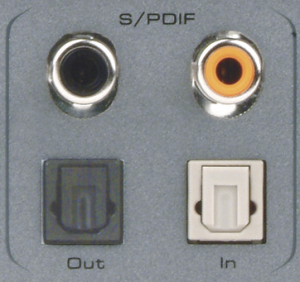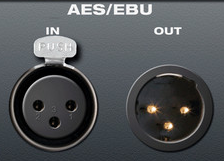Audio data passed from one device to another is referred to as a stream. There are several different formats for transmitting a digital audio stream between devices. In some cases, you might want to interconnect two pieces of equipment digitally, but they don’t offer a compatible transmission protocol. The best thing to do is make sure you purchase equipment that is compatible with the equipment you already have. In order to succeed at this, you’ll need to understand and be able to identify the various options for digital audio transmission.
The most common transmission protocol, particularly in consumer-grade equipment is the Sony/Phillips Digital Interconnect Format (S/PDIF). With S/PDIF you can transmit two channels on a single wire. Typically this means you can transmit both the left and right channels of a stereo pair using a single cable instead of two cables required for analog transmission. S/PDIF can be transmitted electrically or optically. Electrical transmission involves RCA (Radio Corporation of America) connectors and a low loss, high bandwidth coaxial cable. This cable is different from the cable you would use for analog transmission. For S/PDIF you need a cable like what is used for video. S/PDIF transmits the digital data electrically in a stream of square wave pulses. Using cheap, low bandwidth cable can result in a loss of high frequency content that can ultimately lose the square wave form, resulting in data loss. When looking for a cable for electrical S/PDIF transmission, look for something with RCA connectors on each end and an impedance of 75 W.
S/PDIF can also be transmitted optically using an optical cable with TOSLINK (TOShiba-LINK) connectors. Optical transmission has the advantage of being able to run longer distances without the risk of signal loss, and it is not susceptible to electromagnetic interference like an electrical signal. Optical cables are more easily broken so if you plan to move your equipment around, you should invest in an optical cable that has good insulation.

S/PDIF is considered a consumer grade transmission protocol. S/PDIF has a professional grade cousin called AES3, more commonly known as AES/EBU (Audio Engineering Society/European Broadcasting Union). The actual format of the digital stream is almost identical. The main differences are the type of cable and connectors used and the maximum distance you can reliably transmit the signal. AES/EBU can be run electrically as a balanced signal using three pin XLR connectors with a 110 W twisted pair cable or unbalanced using BNC connectors a with a 75 W coaxial cable. The unbalanced version has a maximum transmission distance of 1000 meters as opposed to the 100 meters maximum for the balanced version. The balanced signal is by far the most common implementation as shown in Figure 5.19.

If you need to transmit more than two channels of digital audio between devices, there are several options available. The most common is the ADAT Optical Interface (Alesis Digital Audio Tape). Alesis developed the system to allow signal transfer between their eight-track digital audio tape recorders, but the system has since been widely adopted for multi-channel digital signal transmission between devices at short distances. ADAT can transmit eight channels of audio at sampling rates up to 48 kHz or four channels at sampling rates up to 96 kHz. ADAT uses the same optical TOSLINK cable used for S/PDIF. This makes it relatively inexpensive for the consumer. However, the protocol must be licensed from Alesis if a manufacturer wants to implement it in their equipment.
There are several other emerging standards for multi-channel digital audio transmission, more than we can cover in the scope of this chapter. What is important to know is that most protocols allow digital transmission of 64 channels or more of digital audio over long distances using fiber optic, or CAT-5e cable. Examples of this kind of transmission include MADI, AVB, CobraNet, A-Net, and mLAN. If you need this level of functionality, you will likely be able to purchase interface cards that use these protocols for most computers and digital mixing consoles.